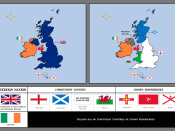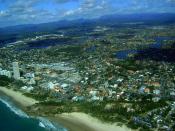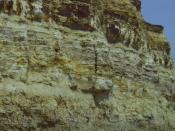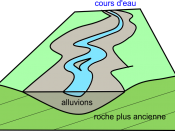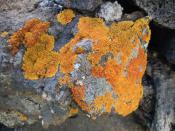Marine erosion can occur in four distinct ways, these being hydraulic action, Corrasion, Attriton and Solution.
Hydraulic action is arguably the most destructive and important of the four processes of marine erosion. It is literally just the force of water smashing bits of rock of the cliff face. On the Western coast of the UK the waves that come from over the Atlantic can exert a pressure of 10,000 kg/m2, and during storms up to 30,000 kg/m2. Waves that break right at the cliff face cause maximum damage, this is because of air pockets that are contained within cliff, between rocks, and when the air in these pockets is compressed for a few seconds we see an explosion that tears chunks of rock off the cliff face. In this way hydraulic action causes the most extensive cliff retreat.
Attrition can be described as the process by which rock fragments that have become detached due to corrasion and hydraulic action erode against eathother.
This happens most obviously on a pebble beach. The process of longshore drift cause pebbles and fragments of rock that have fallen from the cliff face rub against eachother, this can wear the pebbles down further, and therefore allow the sediment to be easily transported down the coastline. This then allows the sea to be right up at the cliff face again where the most effective erosion can take place. Attrition therefore in a slightly less direct way causes cliff retreat.
Corrasion is the process by which fragments of rock are pick up by incoming waves and then thrown back at the cliff face, causing further erosion. The effectiveness of corrasion depends on many things, the most important ones being, strength of wave, height of wave, volume of wave and angularity of the rock. This process tends to be most effective at the base of the cliff and combined with hydraulic action can cause severe undercutting, and therefore mass movement due to cliff face unstability. Once again we can say that cliff retreat is increased due to corrasion
Solution is the only process not to become more rapid with storm conditions. It is much more effective in warm seas, as chemical processes are more effective in warmer waters. It is chemically the attack on limestone by carbonic acid. This process will obviously be moer effective in tropical and sub-tropical areas of the world. Like on Nauru Island in Kenya where limestone pillars left there by solution are evident.
When looking at sub-aerial processes we should consider weathering. The freezing and thawing of cracks where moisture has collected causes erosion, as well as the thermal expanison and contraction of rocks all play there part in weakening the upper parts of the cliff face. Mass Movement will occur fequently on a cliff face if it has been weakened or undercut by various marine processes, and therefore slumping, or rock falls will be common.Obviously the climate of the location affects which process will be most effective. In tropical locations heavy rainfall is the dominant weathering process, whereas in temperate regions freeze thawing and raindrop action will be common as well as general biological weathering.
Rates of erosion may vary considerably due to a number of factors, these could include elements such rock type, type of wave, frequency of wave and the frequency of storm waves.
A coastline that is predominantly struck by spilling waves is unlikely to experience much damage, however if a coastline was battered daily by plunging or collapsing waves, which have much more power and destructiveness then the coastline would experience very rapid retreat. In a similar way, erosion at headlands is likely to be much faster than in a bay, due to the way in which waves refract.
The physical nature of coastlines affect the speed with which they retreat, for example varying rock types have varying speeds of erosion, worldwide figures show that chalk erodes at between 1cm and 1 metre a year, while limestone erodes at a slow 1mm to 1cm a year, the rock with highest rate of erosion yearly is volcanic ash, which can erode at over 10 metres a year.
Weathering and mass movement processes can greatly increase the rate of erosion on a coastline. In the British Isles, due to its relatively cold and temperate climate processess like freeze thaw can occur; this in turn leads to weakening cliff faces and can ultimately lead to mass movement like rock falls. However, in the British Isles the main form of weathering is more likely to be heavy rainstorms which also lead to cliff failure, and cliff retreat. The presence of vegetation on cliffs helps bind the soil/rock and therefore mass movement is less likely to occur, this is mainly the case along humid and tropical coastlines.
Human activities however are arguably the most influencial factor in causing erosion and increasing other methods of erosion. The builing of harbours and coastal towns can increase the amount of pressure on coastline, this added stress and pressure can in turn cause mass movement. The pressure on coastlines is immense; Coastal resorts and leaisure facilities have become an expectation, causing added pressure on coastlines. Mining for minerals is often poorly planned and these mines weaken cliff faces. Coastal towns have now needed to be protected by sea defences, these can also have immense reprocussions further down the coast, the building of groynes for example, these trap sediment which might be vital to protecting settlement and coastline further down the coast.
When we consider rates of erosion and how they vary, we also see how many man made, as well as natural processes affect how fast coastlines are being eroded.
